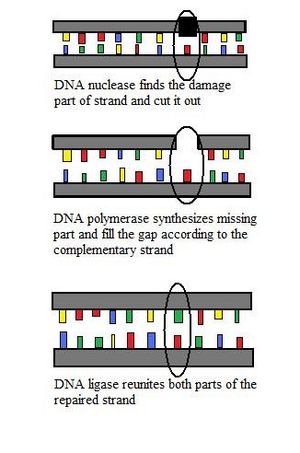DNA Repair
DNA repair mechanisms has a very important role in ensuring the stability of genome. They are able to correct about 99% of transcription errors. The frequency of mismatches (incorrect pairing of bases) is about 1:107 nucleotides.
During the day thousands and thousands of changes are occurring. For their reparation, at least one of the DNA chains has to be intact. The damaged part can then be resynthesized.
When the mismatch has appeared, it is necessary to cut out the affected region of DNA and to synthesize the new one. If DNA repair mechanisms does not do this, the mutation is transmitted to the next generation.
Types of DNA Damage[edit | edit source]
- Modification of bases (loss of amino group)
- Mismatches of the normal bases (failure of DNA replication)
- Breaks of backbone of DNA (the most common cause is radiation)
- Cross-links (linkage between bases)
DNA damage can be caused by:
- chemical changes of DNA structure (nitrogen);
- physical damages (UV light, radiation);
- viral damages.
DNA Repair[edit | edit source]
- DNA damage is recognized by specific enzymes - nucleases. The covalent bond is interrupted and the gap occurs.
- DNA-polymerase binds to the 3´end of DNA and fills the gap according to the complementary strand.
- DNA-ligase reunites the repaired part to the original strand.
Direct Reversal[edit | edit source]
For this repair mechanism it is not necessary to break the DNA backbone. The most common mistakes are caused by methyl group (–CH3). It changes C (cytosin) to T (thymin). This problem is solved by enzymes - glycosylases - which are able to restore it.
Excision Repair[edit | edit source]
DNA strand has to be discontinued in order to be repaired.
- Base Excision Repair (BER)
- Nucleotide Excision Repair (NER)
- Mismatch Repair (MMR)
Diseases with Defects in DNA Repair[edit | edit source]
In past it was discovered that there is a connection between DNA repair defects and developing of cancer (especially intestinal cancer). The heredity of repair genes is recessive. That means that each person has two different copies of the gene (one from each parent) and it is necessary to damage both of them in order for the disease to occur.
Hereditary Nonpolyposis Cancer Syndome (HNCS)[edit | edit source]
Disease which is connected with defect of DNA mismatch repair. Normally the incorrect pairing is repaired. But in this case the errors are accumulated in the cells. Tumor suppressive and Protooncogenes are affected too. This leads to increased risks of developing cancer. Patients with defect of mismatch repair have typically microsatellite instability.
Xeroderma Pigmentosum (XP)[edit | edit source]
Patients with XP have an increased risks of skin cancer. The reason is inability to repair the cross-linking of pyrimidine pairs, which arise from UV-light influence.
Fanconi anemia, Bloom Syndrome, Ataxia-Teleangiectasia[edit | edit source]
Autosomal recessive diseases which are connected with damage of recombination repair genes. DNA is more sensitive to external agents.
Links[edit | edit source]
Related articles[edit | edit source]
Sources[edit | edit source]
- Kimball's Biology Pages. DNA Repair [online]. ©2011. The last revision 2011-03-12, [cit. 2011-07-31]. <http://users.rcn.com/jkimball.ma.ultranet/BiologyPages/D/DNArepair.html>.
Bibliography[edit | edit source]
- KAPRAS, J. – KOHOUTOVÁ, M. – OTOVÁ, B.,. Kapitoly z lékařské biologie a genetiky I. 1.vydání edition. 1996. ISBN 80-7184-322-9.
- SOUKUPOVÁ, M. – SOUKUP, F,. Kapitoly z lékařské biologie a genetiky II. 1.vydání edition. 1998. ISBN 80-7184-581-7.
- KAPRAS, J. – KOHOUTOVÁ, M,. Kapitoly zlékařské biologie a genetiky III. 1.vydání edition. 1998. ISBN 80-246-0001-3.
- ALBERTS, JOHNSON ET ALL,. Základy buněčné biologie. 2.vydání edition. 2005. ISBN 80-902906-2-0.
- KUMAR, ABBAS, FAUSTO, MITCHELL,. Robbins Basic Pathology. 8.vydání edition. 2007. ISBN 978-0-8089-2366-4.


